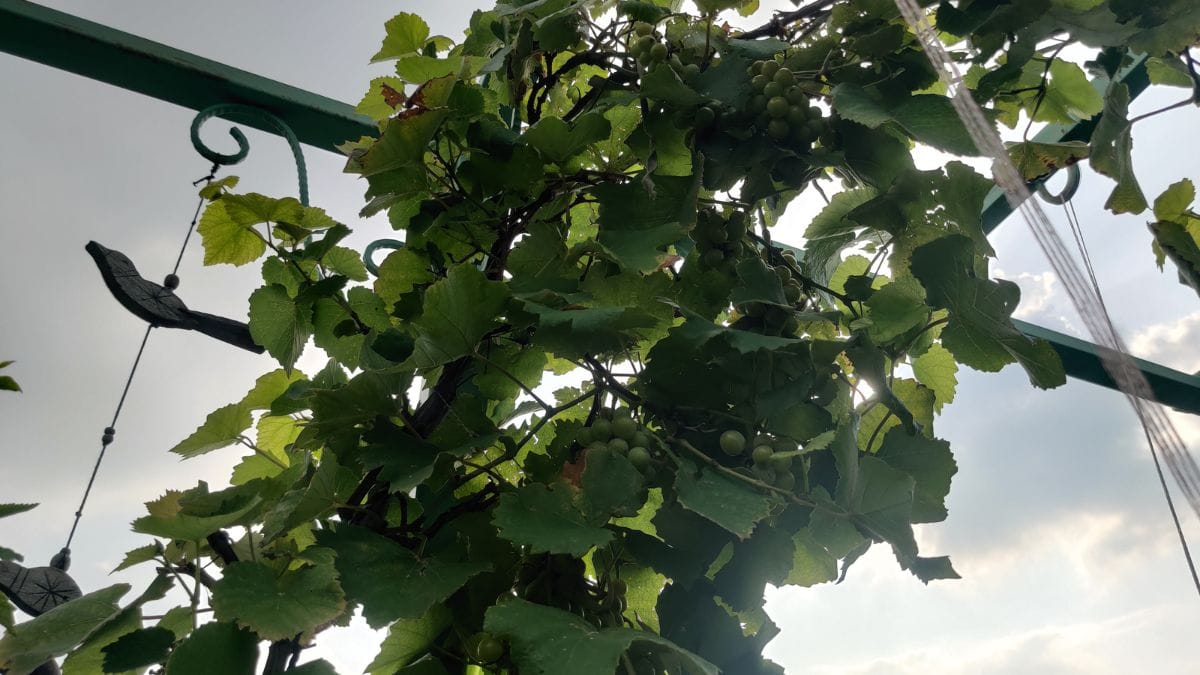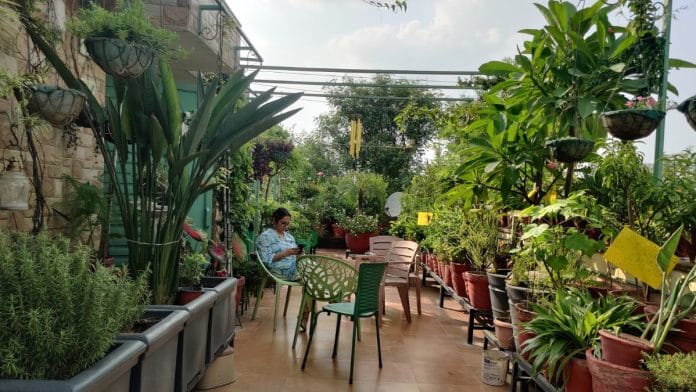New Delhi: The only plant once found on Indian homes was the humble tulsi. That is changing now. A green revolution is taking over balconies and terraces in India.
In Lajpat Nagar, Poonam Ahuja (66) has transformed the 150-square-foot terrace and balcony in her three-storey home into a thriving green haven. She started with a single tulsi plant for morning prayers and now has spinach, sunflowers, brinjals, pumpkins plants, and even citrus trees growing in her vibrant garden.
“I first ordered a few flowering plants and used kitchen seeds to experiment — tomatoes, oranges, brinjals. Some plants flourished on their own,” said Ahuja, who discovered her green thumb in 2020 during the pandemic.
Across Delhi-NCR, a growing number of residents from students to working professionals and retirees are nurturing green spaces in their balconies, terraces and window sills. A city constrained for space, water, clean air and soil now wants to be a city of a thousand mini gardens. And urban gardeners aren’t just growing chrysanthemums and roses. They are also experimenting with edibles, taking joy in the first blush of a new tomato or the length of the green chilli like proud new parents. While some share their small triumphs on social media, others have turned their passion into full-fledged services, workshops, and awareness campaigns. They are the new ambassadors of the city and part of community-driven platforms like Mission Green Delhi and Delhi Greens. In a city that’s become globally infamous for toxic air pollution, these tiny terraces and balconies are thriving.
“Urban farming isn’t just about growing food, it’s about reclaiming health, and reconnecting with nature and the Earth,” said 48-year-old Pravin Mishra, who organises workshops and classes on urban farming.
In many ways, residents like Mishra and Ahuja are picking up where the Delhi government left off. In 2022, the Arvind Kejriwal government introduced a ‘Smart Urban Farming’ initiative — Mukhyamantri Shahri Bagwani Yojna — to promote urban agriculture and food production. It never took off. But residents aren’t waiting for government support. They’re trying to transform how they eat and live.
“What began as borrowed money plants for decoration on windowsills has now blossomed into green corners of peace—small sanctuaries carved out against Delhi’s rising pollution and health crisis,” said urban farmer Narkesh Yadav (60) from Dwarka.
What began as borrowed money plants has now blossomed into green corners of peace. — Narkesh Yadav
The green wave
Mishra and Ahuja are part of Mission Green Delhi — a community-driven blog and platform that brings together urban farming and sustainable living enthusiasts.
Ahuja came across Mishra’s YouTube handle and enrolled in his online class where she learnt about composting, soil health and planting techniques.
“What’s more positive than nurturing life through plants?” said Ahuja, who now tends to over 150 varieties of plants in her terrace and balcony.

Mishra, a postgraduate in journalism, has become one of Delhi-NCR’s more prominent green evangelists, visiting schools, colleges, and RWAs. In 2016, he trained in organic farming at the Krishi Vigyan Kendra and now tends to his 2.5-acre plot in Burari, where he grows a wide variety of seasonal produce — from leafy vegetables like spinach and fenugreek in the winters to fruits such as guava, oranges, pomegranates, and apples, as well as crops like cauliflower, cabbage, bottle gourd, and pumpkin.
We don’t need acres to farm. A pot, a window, a wall—anything can be a starting point. — Pravin Mishra
He’s trained hundreds of households to grow their own food without using synthetic fertilisers, pesticides, or chemicals. His six-month course, priced at Rs 1,000 per month, covers everything from seasonal planting and soil mixing to composting and making bio-enzymes from kitchen waste.
“We don’t need acres to farm, we need awareness and a little knowledge,” said Mishra. “A terrace, a balcony, a wall, a window or even a pot – all can be starting points for a greener tomorrow.”

Hobby to businesses/services
Kishi Arora’s lush terrace garden in her Preet Vihar home is her sanctuary, far from the madding crowd and the chaos that is Delhi.
Her terrace is filled with hundreds of varieties of plants — from aloe vera, areca palm, spider plant, ficus, and money plant to herbs like tulsi, mint, coriander, lemongrass, oregano, rosemary, and curry leaves. The space bursts with colour from sunflowers, jasmine, cosmos, dianthus, hibiscus, and rajnigandha, while vegetables like brinjal, bottle gourd, bitter gourd, potato, beans, zucchini, and carrot grow in neat containers.
Urban farming is about reclaiming health and reconnecting with nature.
She also grows fruits like oranges, grapes, strawberries, blueberries, and guavas, along with several varieties of berries. Birds nest in thoughtfully placed shelters, butterflies flit from bloom to bloom, and honeybees hum gently in the background. Wind chimes hanging at the centre of the terrace add a melodious note to the atmosphere.

“Planting is much more than just putting seeds in the soil. It creates a whole ecosystem where multiple forms of life coexist and thrive,” said Arora, as she pointed to a small, colourful bird — a picidae, or woodpecker — repeatedly dipping its beak into the well of a flower.
Baker, chef, entrepreneur, urban gardener, food consultant, and social media influencer, Arora wears many hats. But the title she cherishes most is that of a ‘plant parent.’ With over 56.7K followers on Instagram, her inbox is overflowing with questions from strangers and followers.
“You have to give your plants time and attention, just like you would with a baby,” she said. “You need to truly love them, not just like them, if you want to see results.” Arora also shares simple, sustainable gardening tips using everyday plant waste. For instance, she collects citrus fruit peels—like lemon and orange—blends them into a juice, and sprays it on her plants to naturally protect them from insects. Another favourite trick of hers is using aloe vera to make a homemade fertiliser, giving her plants a gentle, organic boost.

Showing off bunches of grapes and several varieties of berries, Arora walked over to a vine trailing across the terrace and gently plucked a ripe cluster of black grapes, then another of green ones. Nearby, pots brimmed with berries—plump blueberries, deep-purple Java plums, sweet mulberries, and bright red strawberries.
Her garden’s bounty, she explained, has become more than a personal passion—it’s now a part of her livelihood. In her sun-drenched kitchen, rows of neatly labelled jars filled with vibrant, homemade jam sit cooling on the counter. She offers a packaged box of two 250-gram jars—made with the fruit or berry of your choice—for Rs 1,500. Sold under her brand Foodaholics, these jams are available on her website, which also features a selection of homemade bakery items.
Like Arora, urban farmer Kavinder Yadav and his mother Narkesh have turned their passion into a brand, NK Greens, a terrace and balcony gardening service. They’ve also launched their own plant fertiliser, ShaktiGro Plant Elixir.

Communities like Mission Green Delhi and Delhi Greens are also playing a significant role in spreading awareness and encouraging eco-friendly lifestyles. These groups provide platforms for like-minded individuals and organise awareness campaigns and workshops, often in collaboration with Resident Welfare Associations (RWAs) across the city.
Delhi Greens has partnered with RWAs in Rohini, Pitampura, South Delhi, Dwarka, and several Delhi University colleges to conduct workshops on the basics of planting and terrace gardening.
“Collective activities are always more effective,” said an RWA member in Dwarka. “When one society hosts a workshop, others are inspired to follow suit. Similarly, when people hear about someone’s gardening journey and its benefits, they feel motivated to try it themselves.”
A long-delayed initiative
For this growing tribe of gardeners, the lack of government support remains a thorny issue. Most of the initiatives never take off, said RWA members. A case in point is the Smart Urban Farming initiative.
The goal was to expand Delhi’s green belt, and make the city a national model for urban farming, said Gopal Rai, who was Delhi’s Minister for Environment, Forest & Wildlife, Development, and General Administration at the time. He had launched the initiative alongside former Chief Minister Arvind Kejriwal.
“It was formally announced, but stalled due to pending approvals from the state government. Its progress was further delayed by the onset of elections,” said Rai. “There’s a rising public interest in organic food, home-grown produce, and environmentally conscious lifestyles. The initiative was designed to tap into that interest by training citizens, especially women and youth, in home farming techniques.”
Plants come with solutions, not problems. — Kishi Arora
The Delhi Forest Department was also involved in the planning phase. A senior official from the department stated that they held multiple meetings with Resident Welfare Associations (RWAs), local residents, and government officials. “The plan was always ready, but we never got the opportunity to implement it,” the official said.
Now, the project has been shelved; its ambitious goal of promoting urban self-sufficiency forgotten. But Mishra and the others have stepped in.
Other Indian states have had more success. Kerala offers subsidies for vertical garden structures as part of its urban agriculture drive. Tamil Nadu launched the Urban Horticulture Development Scheme in 2014, providing DIY kits for city gardeners. And since 2021, Bihar has also been actively promoting terrace gardening in urban areas.
While urban farming offers a sustainable alternative to traditional food systems, it also comes with its own set of challenges.
“Space is the biggest issue when it comes to planting on a large scale, and it becomes even more difficult if you’re living in a flat with your entire family,” said Divya Sharma (26), a resident of Dwarka who uses her small balcony as a kitchen garden. “I can’t use the terrace because it’s a common area shared by the whole building,” she added.
The idea of urban community gardening and farming—common in Europe, America and parts of Asia—have yet to find space here.
Water, or the lack of it, especially during Delhi’s brutal summers is another challenge.
But Arora doesn’t see them as hurdles but stepping stones to a greener future.
“More than space, water, or soil, they need patience and care. Plants come with solutions, not problems,” she said.
(Edited by Prashant)






